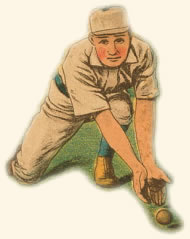|
The Baseball Glove
Comes to Baseball, 1875
Baseball developed before the Civil War but did not achieve professional status until the 1870s. The Cincinnati Red Stockings became the first professional team in 1869. However, their life was brief and the team went bankrupt within a year of its founding. In 1871 the National Association of Professional Baseball Players was formed and at its peak, consisted of thirteen teams. Unfortunately it too was plagued by financial difficulties and was abandoned in 1875. The
 |
Sam Barkley
1st Base, Pittsburgh
from a contemporary
baseball card, 1887
|
following year saw the formation of the National League of Professional Baseball Players (soon shortened to the National League). In 1884 the rival American League was founded and the era of modern professional baseball was begun.
In these early days of baseball, players were expected to take the field without benefit of protective equipment such as a baseball glove or catcher's mask. The pain of the sport was to be endured without complaint. Any effort to mollify the rigors of the game was looked upon as a sissified attempt to demean the sport.
A.G. Spalding began playing baseball in the 1860s. He joined the Boston Red Stockings in 1871 and moved to the Chicago White Stockings (today's Cubs) in 1876. Spalding was the premier pitcher of his day until the physical strain of continuous pitching took its toll and ruined his throwing arm. He founded a sporting goods company initially specializing in baseball equipment and soon branching out to supplying equipment for all types of sports. He never lost touch with baseball and served as president of the Chicago team and one of baseball's most successful promoters. He was inducted into the Baseball Hall of Fame in its first year.
In 1911, Spalding wrote of his experiences in early baseball and describes his first introduction to the baseball glove:
"The first glove I ever saw on the hand of a ball player in a game was worn by Charles C. Waite, in Boston, in 1875. He had come from New Haven and was playing at first base. The glove worn by him was of flesh color, with a large, round opening in the back. Now, I had for a good while felt the need of some sort of hand protection for myself. In those days clubs did not carry an extra carload of pitchers, as now. For several years I had pitched in every game played by the Boston team, and had developed severe bruises on the inside of my left hand. When it is recalled that every ball pitched had to be returned,
 |
Tom Forster
Shortstop, Milwaukee
from a contemporary
baseball card, 1887
|
and that every swift one coming my way, from infielders, outfielders or hot from the bat, must be caught or stopped, some idea may be gained of the punishment received.
Therefore, I asked Waite about his glove. He confessed that he was a bit ashamed to wear it, but had it on to save his hand. He also admitted that he had chosen a color as inconspicuous as possible, because he didn't care to attract attention. He added that the opening on the back was for purpose of ventilation.
Meanwhile my own hand continued to take its medicine with utmost regularity, occasionally being bored with a warm twister that hurt excruciatingly. Still, it was not until 1877 that I overcame my scruples against joining the 'kid-glove aristocracy' by donning a glove. When I did at last decide to do so, I did not select a flesh-colored glove, but got a black one, and cut out as much of the back as possible to let the air in.
Happily, in my case, the presence of a glove did not call out the ridicule that had greeted Waite. I had been playing so long and had become so well known that the innovation seemed rather to evoke sympathy than hilarity. I found that the glove, thin as it was, helped considerably, and inserted one pad after another until a good deal of relief was afforded. If anyone wore a padded glove before this date I do not know it. The 'pillow mitt' was a later innovation."
References:
Spalding, Albert G., America's National Game (1911); Wallop, Douglass, Baseball; an Informal History (1969). Ward, Geoffrey C., Baseball: an Illustrated History (1994).
How To Cite This Article:
"The Baseball Glove Comes to Baseball, 1875", EyeWitness to History, www.eyewitnesstohistory.com (2004).
|






